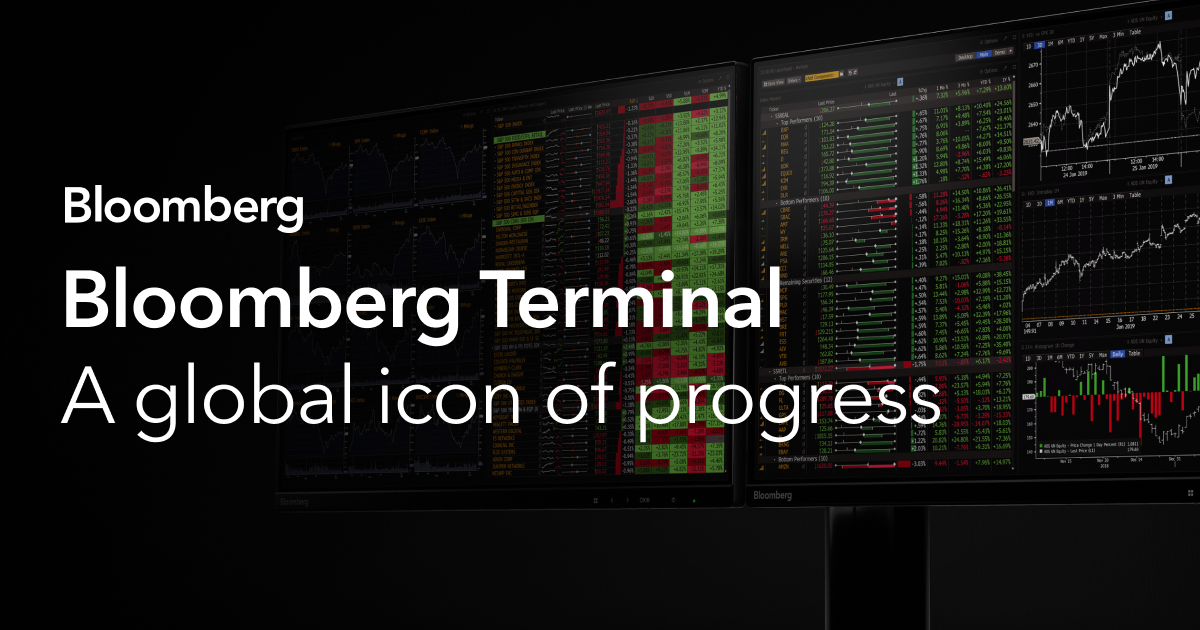Asset management is evolving rapidly, and Artificial Intelligence (AI) is at the heart of this transformation. AI is redefining how investment decisions are made, how portfolios are optimized, and how risks are managed.
In this blog post, we will explore how AI is revolutionizing the asset management industry, its applications, the benefits it brings, and how firms can leverage these technologies to stay ahead of the curve.

1. Introduction
1.1 What is Asset Management?
Asset management refers to the professional management of various securities and assets—such as stocks, bonds, real estate, and other investments—to meet specific investment goals.
Investment managers typically aim to maximize returns for clients while minimizing risks. The process involves asset allocation, portfolio diversification, and continuous monitoring and rebalancing to ensure the portfolio remains aligned with the client’s goals.
1.2 The Role of Artificial Intelligence in Asset Management
AI is fundamentally changing how asset managers make decisions. By using machine learning (ML), predictive analytics, and other advanced AI techniques, asset managers can analyze vast datasets faster and more accurately than ever before. AI helps identify market trends, optimize portfolios, predict risks, and automate many back-office functions, ultimately enhancing decision-making processes.
Read more: Machine Learning in Asset Management: A Game-Changer
1.3 Why AI is a Game-Changer for the Asset Management Industry
AI is a game-changer for asset management because it enables asset managers to make data-driven decisions at a speed and scale previously unimaginable. It can predict market movements, optimize portfolio performance, and uncover new investment opportunities. As the demand for faster, more accurate decision-making increases, AI has become an essential tool for firms looking to stay competitive.
2. Understanding AI in Asset Management
2.1 What is AI-Driven Asset Management?
AI-driven asset management refers to the use of AI technologies such as machine learning and predictive analytics to assist in the management of assets. This includes automating tasks like portfolio construction, rebalancing, risk assessment, and even asset selection, helping managers make more informed and timely decisions.

2.2 Core Technologies Behind AI in Asset Management
AI in asset management relies on several core technologies:
- Machine Learning (ML): Enables systems to learn from data and improve over time without being explicitly programmed.
- Predictive Analytics: Uses historical data to predict future trends and outcomes, such as market movements or portfolio returns.
- Generative AI: Generates new insights or investment strategies based on existing data, helping managers create innovative solutions.
- Natural Language Processing (NLP): Analyzes unstructured data such as news articles and social media to gauge market sentiment.
Read more: Master AI Tech Stacks for 2025: The Ultimate Guide
2.3 The Evolution of Asset Management
Historically, asset management involved manual processes such as fundamental analysis, spreadsheets, and periodic reviews of portfolios. With the advent of AI, these processes are now automated, making them faster, more accurate, and scalable. AI tools help asset managers optimize their strategies by continuously analyzing market data, identifying patterns, and adjusting portfolios in real time.
3. Applications of AI in Asset Management
3.1 Portfolio Optimization
AI enables better portfolio optimization by analyzing large datasets, identifying trends, and recommending adjustments to ensure the portfolio remains aligned with the client’s goals. Machine learning algorithms can also help assess risk and predict which assets are likely to deliver the best returns.
BlackRock’s Aladdin platform is a game-changer when it comes to portfolio optimization. By harnessing the power of AI and machine learning, Aladdin processes vast datasets in real time to help asset managers identify optimal portfolio allocations. Think of it as an intelligent assistant that continuously monitors market conditions, helping portfolio managers reduce risk and seize opportunities.
The platform doesn’t just automate tasks; it’s a strategic tool that ensures portfolios are tailored to meet both short-term and long-term goals, making it a favorite among major asset managers.
3.2 Predictive Market Analysis
Since AI tools can analyze vast amounts of data from financial reports to news articles and social media, it gives asset managers real-time insights into market trends. By predicting trends and identifying emerging opportunities, AI helps managers stay updated with the latest information which is the key for asset management in the competition.
When it comes to market analysis, Bloomberg Terminal is a powerhouse. Leveraging AI, it sifts through a mountain of financial data, news, and economic reports to provide investors with deep insights into emerging trends.
Its News Analytics tool, for instance, analyzes market sentiment by evaluating news sources and social media chatter to forecast market movements. Imagine being able to spot a promising stock before everyone else, thanks to AI, Bloomberg users gain an edge, identifying trends and opportunities with pinpoint accuracy before they hit mainstream radar.
3.3 Risk Management
AI can also identify risks earlier and more quickly based on historical data and current market conditions stored from previous findings. Machine Learning models will assess a wide range of variables, from interest rate fluctuations to geopolitical events, allowing asset managers to proactively adjust portfolios to minimize risks. Not only that but AI also suggests multiple options and strategies in risk management that suit perfectly with specific needs or requirements.
JP Morgan’s COIN platform is revolutionizing risk management by taking a proactive approach to monitoring market risks. This AI-powered system uses natural language processing to analyze legal contracts, but its true value lies in how it helps the bank predict and mitigate financial risks.
COIN’s algorithms can detect early signs of trouble by scanning vast amounts of structured and unstructured data. Whether it’s a sudden market shift or a potential legal pitfall, the platform flags risks before they escalate, empowering the bank to adjust its strategies and protect its assets.
3.4 Fraud Detection and Prevention
AI systems are becoming more adept at detecting fraudulent activities by analyzing transaction patterns and identifying anomalies. By using AI to monitor transactions in real time, asset managers can reduce the likelihood of fraud, ensuring greater security and compliance. Especially in high traffic circumstances, AI can supervise the entire process of stakeholders and trigger red flags or warnings to head up asset managers any hazard.
Mastercard is leading the way in fraud prevention, using cutting-edge AI to monitor transactions in real-time. Their Decision Intelligence system analyzes transaction data at lightning speed, instantly flagging suspicious activities. This goes beyond simple fraud detection—it’s a sophisticated AI model that learns from every transaction, constantly evolving to identify new fraud tactics.
When an unusual transaction occurs, AI steps in, preventing unauthorized transactions before they even have a chance to disrupt the system. For asset managers, this level of security is crucial, ensuring that investments stay safe in a world where cyber threats are ever-present.
3.5 Automation in Back Office
AI automates many routine tasks in asset management, such as report generation, client communications, and compliance checks. This reduces not only operational costs and frees up human resources to focus on more strategic activities but also time spent waiting for analysis, reports, or checkups.
For a company like Vanguard, known for its scale and efficiency, automation is key to staying competitive. Vanguard has implemented Robotic Process Automation (RPA) to handle the heavy lifting in its back-office operations. From automating routine tasks like account reconciliations to managing compliance-related paperwork, RPA frees up human talent to focus on higher-value work. What’s truly remarkable is that Vanguard uses AI-powered bots to process large volumes of data with a level of accuracy that would be difficult, if not impossible, for humans to match. The result? Faster, error-free operations that allow the firm to serve clients more effectively.
3.6 Personalizing Investment Strategies
Personalization is one of the key components in maintaining a high level of customer satisfaction that every business must take into consideration nowadays. And with that, AI helps asset managers create personalized investment strategies tailored to each client’s financial goals, risk tolerance, and preferences. By analyzing vast amounts of client data, AI systems can offer tailored recommendations, making the investment process more client centric.
Betterment is at the forefront of personalized investing, offering an AI-powered robo-advisory service that tailors investment strategies to each client’s unique needs. The platform evaluates personal factors—such as risk tolerance, financial goals, and investment horizons—and creates a customized portfolio based on those preferences.
Unlike traditional wealth management, Betterment’s AI continuously monitors market changes, adjusting portfolios automatically in response to shifting conditions. This hands-off approach provides clients with a dynamic investment strategy that adapts as they progress toward their financial goals, without the need for constant intervention.
4. Benefits of AI in Asset Management
AI in asset management isn’t just a passing trend—it’s a transformative force reshaping how firms operate and deliver value. From enhancing decision-making to boosting efficiency, here are the key advantages asset managers can gain by embracing AI.

4.1 Enhanced Decision-Making Accuracy
Better, smarter decisions—every time.
AI’s data-crunching power allows asset managers to analyze vast quantities of data, providing more accurate insights into market trends and potential investments. By reducing human error and bias, AI empowers professionals to make informed, rational decisions based on data rather than intuition. AI’s predictive analytics are a great way to forecast asset behavior, market conditions, and even the impact of geopolitical events.
4.2 Improved Efficiency and Cost Savings
Cutting costs while increasing productivity.
AI can streamline back-office operations, from automating data entry to facilitating regulatory compliance. Processes that once took hours or even days can now be completed in minutes, freeing up human talent to focus on higher-value activities. The result? Cost reductions and increased productivity across the board. AI helps eliminate manual processes that are prone to errors, making operations leaner and more efficient.
4.3 Real-Time Insights and Analytics
Staying ahead with real-time intelligence.
The financial world moves fast—very fast. AI provides asset managers with real-time insights, allowing them to act on market fluctuations the moment they occur. By using machine learning to analyze market data, AI can spot emerging trends, shifting market sentiments, and even anticipate price movements, helping managers stay ahead of the curve.
4.4 Tailored Client Experiences
Personalization at scale.
In asset management, one-size-fits-all solutions rarely work. AI empowers firms to tailor investment strategies for each client. By analyzing personal preferences, risk tolerance, and financial goals, AI creates individualized portfolios. This kind of hyper-personalized service boosts client satisfaction and retention, as investors feel more confident that their financial needs are being met.
4.5 Competitive Advantage
AI as a differentiator in a crowded market.
In an industry as competitive as asset management, firms need a cutting edge to stay relevant. AI provides just that. By adopting AI technologies, firms can offer services that outperform competitors, reduce risks, and deliver exceptional client experiences. In essence, AI isn’t just a tool—it’s a way for firms to set themselves apart.
5. Challenges and Risks of AI in Asset Management
While the benefits of AI are clear, its integration into asset management also comes with challenges. Here’s a look at the risks firms need to consider.
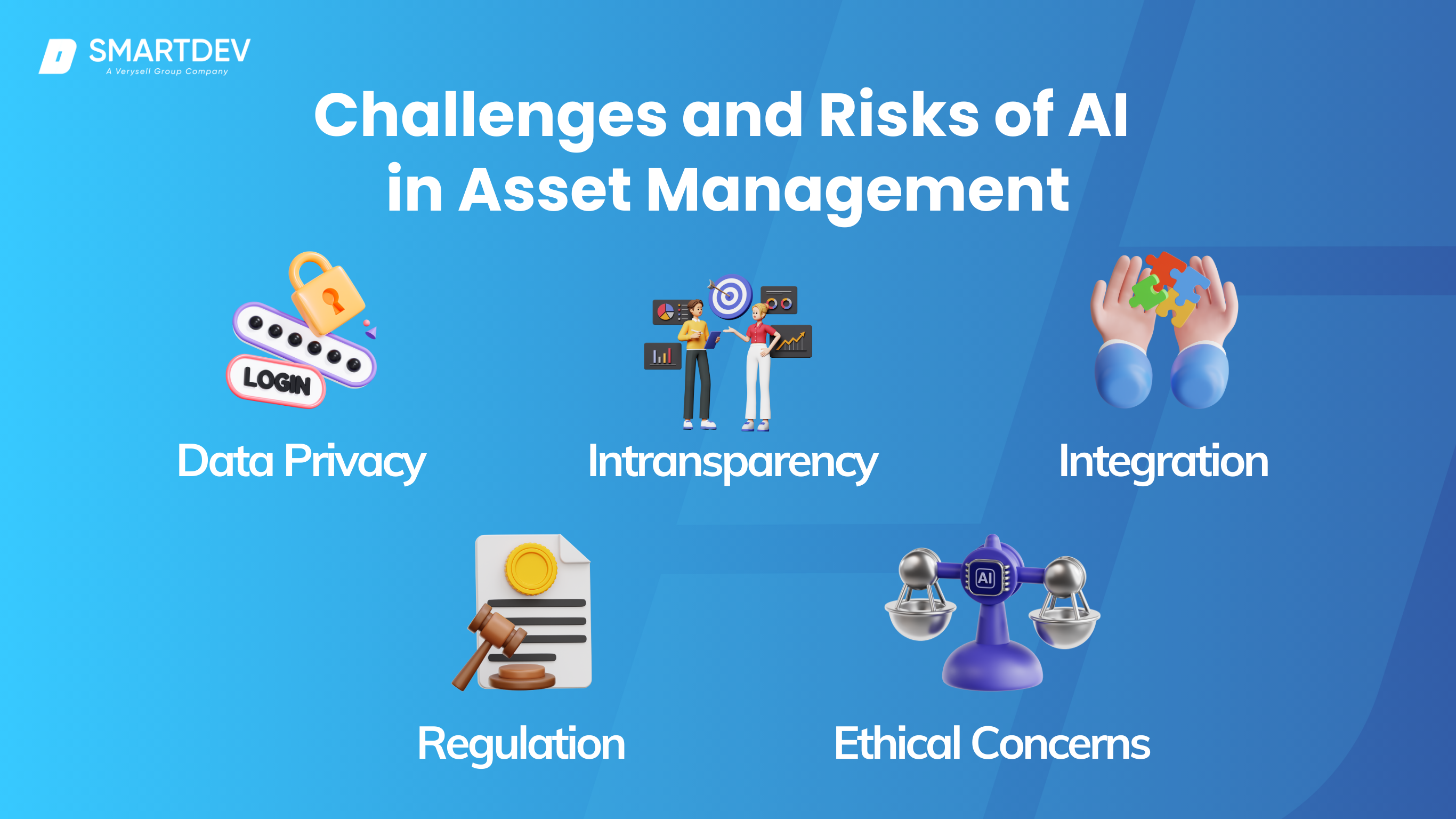
5.1 Guarding Sensitive Information
One of the major challenges that we are all facing is data privacy. Personal security is critical when dealing with sensitive client information. AI systems require vast amounts of data to function effectively, but this raises concerns about the protection of personal and financial data.
5.2 Trusting What You Can’t See
One of the most significant challenges with AI is the lack of transparency in how decisions are made. Many AI models are complex, with outcomes based on patterns that aren’t easily interpretable. This can be problematic in asset management, where clear explanations for investment decisions are crucial. The black box problem can undermine trust between firms and clients.
5.3 Old Systems, New Technologies
Integrating AI into existing legacy systems can be a nightmare for asset managers. Many financial institutions have well-established infrastructure that may not be compatible with AI technologies. Transitioning to AI requires a careful, step-by-step approach to ensure smooth integration while minimizing downtime.
5.4 Keeping Up with Regulation
The regulatory environment surrounding AI in asset management is still evolving. Firms must ensure that their AI-driven strategies comply with existing regulations, while also preparing for future regulatory changes. Failure to meet compliance requirements could lead to fines or legal consequences.
5.5 The Morality of Algorithms
AI-driven decisions can sometimes result in biases that affect outcomes, particularly when the data fed into AI models contains inherent biases. This raises ethical concerns, particularly in areas like credit scoring or wealth distribution. Asset managers must be vigilant in monitoring AI systems for fairness and equity, ensuring that AI decisions align with ethical standards.
6. AI in Asset Management Use Cases
Now let’s take a deeper dive into real-world applications of AI in asset management. Here are several innovative use cases transforming how the industry operates.
6.1 Equity Management
Before AI
Stock selection was largely driven by fundamental analysis (assessing company financials, earnings reports, and industry trends) or technical analysis (studying historical price patterns). This process was manual, time-consuming, and prone to human bias. Even the most experienced asset managers could only analyze a limited number of stocks at a time.
AI-Powered Transformation
AI models now analyze millions of data points—including financial reports, earnings calls, social media sentiment, and macroeconomic indicators—to predict stock movements with greater accuracy than human analysts.
Impact & Results: Renaissance Technologies’ Medallion Fund
This AI-driven hedge fund achieved an average annual return of 66% before fees (39% after fees) from 1988 to 2021, significantly outperforming traditional funds (Source).
6.2 Fixed-Income Investments
Before AI
Evaluating credit risk involved relying on credit rating agencies and analyzing financial statements, a process that was often static and slow to respond to changing market conditions.
AI-Powered Transformation
AI-driven credit risk models continuously monitor real-time financial transactions, economic indicators, and company behaviors, providing early warnings of potential defaults.
Impact & Results: JPMorgan Chase’s COiN Platform
By implementing AI to analyze legal documents, JPMorgan reduced 360,000 hours of manual labor annually, streamlining credit risk assessment and operational efficiency.
6.3 Alternative Investments
Before AI:
Alternative investments required intensive research and insider knowledge, with opportunities often identified through networking and subjective expertise, limiting accessibility.
AI-Powered Transformation:
AI processes alternative datasets—such as satellite imagery and social media trends—to uncover investment opportunities before they become apparent to human analysts.
Impact & Results: Two Sigma Investments
This AI-driven hedge fund has consistently delivered strong performance by leveraging machine learning to identify alternative investment opportunities, contributing to its reputation as a leading quantitative investment firm.
6.4 Real Estate Portfolio Management
Before AI:
Real estate asset managers relied on manual property appraisals and historical sales data, resulting in static valuations that did not adapt to real-time market changes.
AI-Powered Transformation:
AI-driven platforms analyze market trends, interest rates, demographic shifts, and economic indicators to predict property values with higher accuracy.
Impact & Results: Zillow’s Zestimate Model
By incorporating AI, Zillow improved its property valuation accuracy, providing more reliable data for buyers and investors.
6.5 Environmental, Social, and Governance (ESG) Investment Strategies
Before AI
ESG investment decisions were based on self-reported company data and third-party ratings, leading to slow, inconsistent, and sometimes unreliable assessments.
AI-Powered Transformation
AI scans global news, social media, financial disclosures, and government reports to independently assess ESG performance, allowing asset managers to detect greenwashing and respond swiftly to ESG risks.
Impact & Results: BlackRock’s Aladdin Platform
By integrating AI, Aladdin offers sophisticated risk analytics and comprehensive portfolio management tools, enhancing the ability to assess ESG factors and manage risks effectively.
7. Tools and Platforms Leveraging AI in Asset Management
AI tools are reshaping the asset management landscape, and a number of platforms are at the forefront of this change. Here’s a breakdown of some key AI-powered tools.
7.1 Top AI-Driven Platforms for Asset Managers
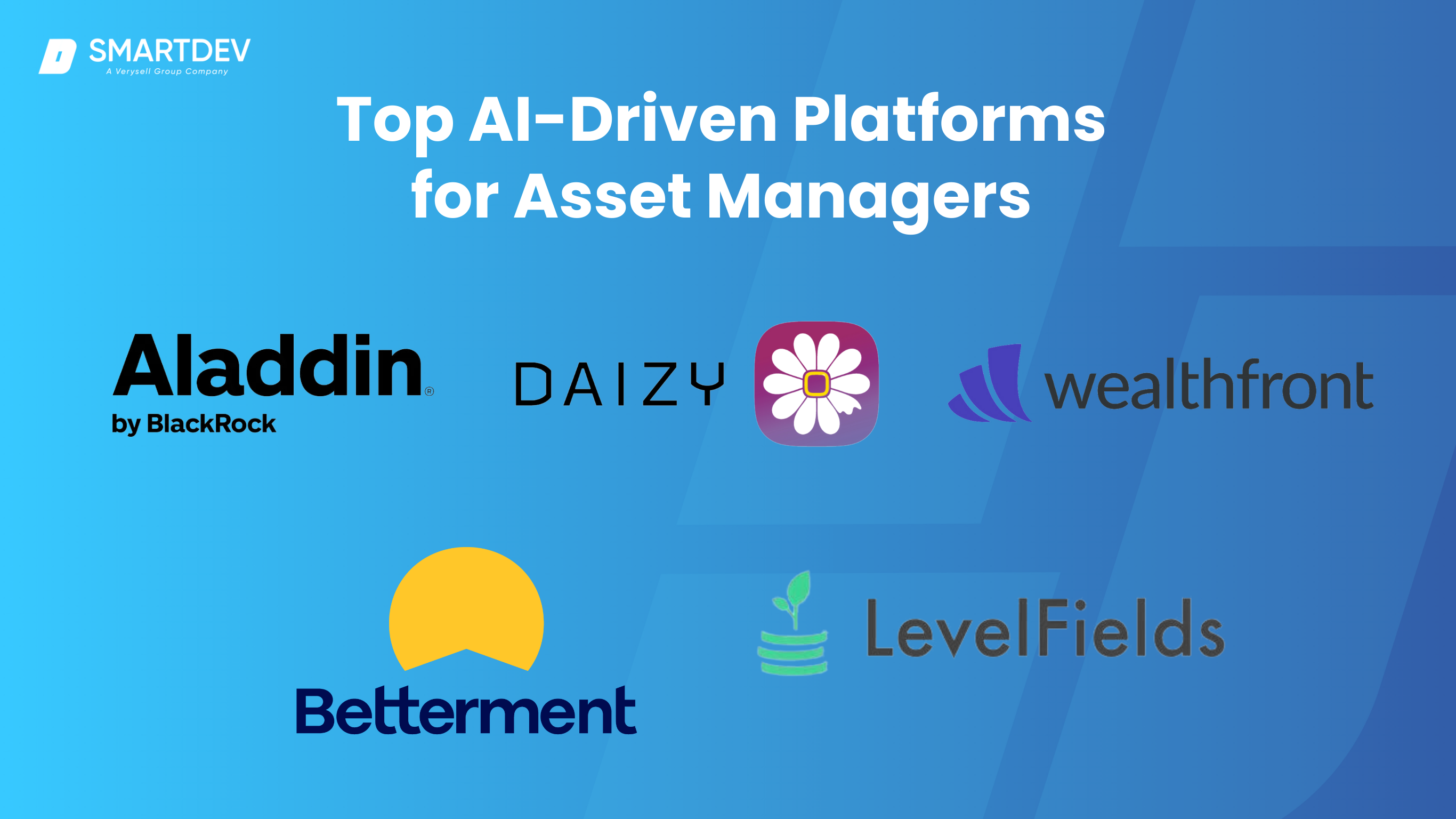
- BlackRock’s Aladdin
Aladdin (Asset, Liability, Debt, and Derivative Investment Network) is BlackRock’s comprehensive platform that integrates sophisticated risk analytics and portfolio management tools. It serves a vast clientele, including asset managers, banks, and insurers, by providing insights into risk assessment and investment decision-making.
- Daizy
Founded in 2018, Daizy offers an AI-powered platform focusing on investment transparency. It provides portfolio, cryptocurrency, and ETF analytics, assisting investors and financial advisors with actionable intelligence, particularly in sustainability (ESG) and risk assessment.
- Betterment
Betterment is a leading robo-advisor that utilizes AI to automate investment management. It collects clients’ financial information and goals, then employs algorithms to offer advice and manage assets, optimizing portfolio performance with minimal human intervention.
- Wealthfront
Similar to Betterment, Wealthfront leverages AI to provide automated investment services. It uses sophisticated algorithms to manage portfolios, aiming to maximize returns based on individual risk tolerance and financial objectives.
- LevelFields
LevelFields offers AI-driven tools designed to analyze vast amounts of market data, track real-time stock movements, and provide data-driven insights, assisting investors in making informed decisions.
7.2 Features to Look for in AI-Based Asset Management Tools
When selecting an AI-driven asset management platform, consider the following key features to ensure it meets your investment and operational goals:
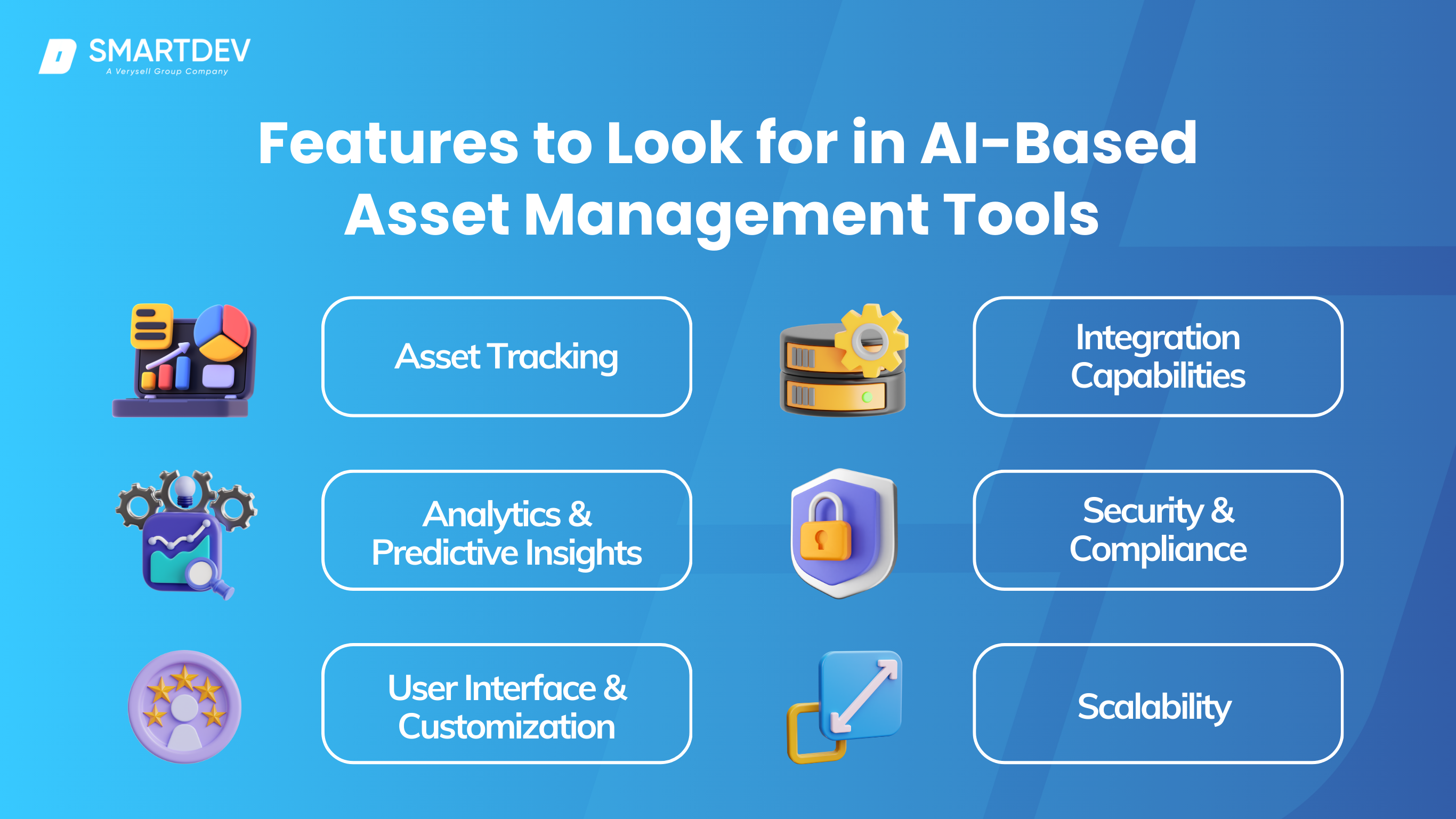
- Comprehensive Asset Tracking and Management: The platform should provide a unified view of all assets, enabling efficient tracking and decision-making. This reduces errors and ensures real-time oversight of your portfolio.
- Advanced Analytics and Predictive Insights: Look for tools that offer predictive analytics to forecast market trends and identify potential risks. AI-driven risk analysis helps managers take proactive measures, improving both profitability and security.
- User-Friendly Interface and Customization: An intuitive interface is essential for ease of use. The platform should also allow customization of dashboards and reports to fit your specific needs, enhancing user experience and efficiency.
- Integration Capabilities: Ensure the platform can integrate seamlessly with existing systems like CRMs and trading platforms, improving workflow efficiency. Consider deployment flexibility, whether cloud-based or on-premises.
- Security and Compliance: Security features, such as encryption and access controls, are essential to protect sensitive financial data. The platform must also meet regulatory requirements, ensuring compliance and reducing risk.
- Scalability for Growth: The tool should be scalable to accommodate increasing assets and evolving investment strategies as your portfolio grows, ensuring it remains effective long-term.
7.3 The Role of Generative AI in Asset Management
Generative AI is a cutting-edge technology that creates new content or predictions based on existing data. In asset management, generative AI can forecast market behavior, generate new investment strategies, and even create synthetic financial data for stress-testing purposes. Its ability to generate novel insights is revolutionizing strategy development.
8. AI’s Impact on Portfolio Management
The impact of AI on portfolio management is profound, especially in terms of speed and precision. Here’s a look at how AI is reshaping this space.
8.1 Predictive Asset Allocation Models
AI algorithms can analyze market conditions in real-time, adjusting portfolio allocations to maximize returns based on predictive models. Whether it’s shifting between asset classes or fine-tuning allocations, AI ensures that portfolios are continually optimized for changing market conditions.
8.2 Real-Time Portfolio Adjustments Based on Market Signals
Unlike traditional portfolio management, which may require manual intervention, AI can make real-time adjustments based on market signals. If an AI platform detects that a particular sector is underperforming, it can instantly reallocate funds to better-performing assets, ensuring optimal performance at all times.
8.3 AI in Rebalancing Portfolios
Portfolio rebalancing is an essential yet time-consuming task. AI automates this process, ensuring that portfolios are rebalanced according to predefined investment goals and market conditions. By using predictive models, AI can determine the best time to rebalance, maximizing potential returns and minimizing risk.
9. Human + AI Collaboration in Asset Management
AI isn’t replacing asset managers; it’s enhancing their capabilities. Here’s how human expertise and AI can work together for more powerful results.

9.1 Augmenting Asset Manager Expertise with AI Insights
AI provides asset managers with insights that go beyond human analysis. By quickly processing vast data sets, AI can uncover trends or investment opportunities that might not be immediately apparent. However, the human touch—intuitive decision-making and experience—still plays a vital role in interpreting those insights and applying them in real-world scenarios.
9.2 Hybrid Models: Balancing Automation and Human Judgment
Rather than replacing human judgment, AI augments it. Hybrid models that blend AI and human expertise are proving to be the most effective approach. AI handles routine tasks, data processing, and analysis, while humans apply their expertise to make strategic decisions that consider emotional and market factors.
9.3. The Role of Asset Managers in an AI-Powered Future
As AI continues to evolve, asset managers will transition into roles where they oversee AI-driven systems, ensuring that algorithms are aligned with client goals and values. The future of asset management will see humans and AI working in tandem to deliver superior results.
10. Regulatory and Compliance Aspects of AI in Asset Management
As AI continues to reshape asset management, regulatory and compliance considerations are becoming increasingly crucial. Governments and financial institutions worldwide are implementing guidelines to ensure AI-driven financial services remain ethical, transparent, and secure. Understanding these regulations is essential for firms looking to integrate AI into their operations without running into legal hurdles.
10.1 Navigating AI-Specific Regulations in Financial Services
The financial industry is subject to strict regulations to protect investors, prevent fraud, and ensure market stability. AI introduces additional complexities, as regulators seek to balance innovation with accountability. Some of the key AI-related regulations affecting asset management include:
- GDPR (General Data Protection Regulation – EU): Ensures AI systems handle client data securely and transparently.
- SEC & FINRA (US): AI-driven trading and asset management must comply with anti-fraud and transparency regulations.
- MiFID II (EU Markets in Financial Instruments Directive): Requires AI-based investment recommendations to be explainable and fair.
- UK AI Regulation Framework: Aims to ensure that AI systems used in financial services remain ethical and accountable.
💡 Tip for Beginners: Start by reviewing AI-related financial regulations in your region. Many regulatory bodies offer beginner-friendly summaries or compliance toolkits that simplify complex requirements.
10.2 Ensuring Transparency and Accountability in AI Models
As mentioned above, one of the major challenges of AI in asset management is the “black box” problem. Regulators demand explainable AI (XAI) to ensure transparency in investment decisions.
To stay compliant:
✔ Use Explainable AI Models: Choose AI solutions that offer insights into how decisions are made.
✔ Document AI Decision-Making: Keep records of how AI algorithms function to satisfy regulatory audits.
✔ Perform Regular AI Audits: Establish internal review processes to check AI recommendations for fairness and accuracy.
💡 Tip for Beginners: If you’re new to AI transparency, look for asset management platforms that provide built-in explainability features, which allow you to see how AI reaches its conclusions.
10.3 Meeting ESG Criteria with AI
Environmental, Social, and Governance (ESG) investing is under increasing scrutiny, with regulators demanding greater transparency in how ESG-compliant investments are selected. AI can help ensure ESG investments are genuine by analyzing alternative data sources, such as:
- News sentiment analysis to detect greenwashing
- Supply chain data to assess ethical sourcing
- Carbon footprint analysis of companies
To stay compliant with ESG regulations:
✔ Use AI tools designed for ESG analysis to ensure investment strategies align with real sustainability metrics.
✔ Monitor regulatory changes related to ESG disclosures, as rules continue to evolve.
💡 Tip for Beginners: Start with AI-powered ESG platforms like MSCI ESG Ratings or Sustainalytics to help verify the credibility of sustainability claims in your investment portfolio.
11. Future Trends in AI and Asset Management
AI’s influence on asset management is just beginning. As technology advances, new possibilities emerge. Here’s a look at some of the future trends to watch out for:
Trend No.1: Generative AI in Shaping Investment Strategies
Generative AI is expected to take investment strategy creation to new heights. By simulating different market scenarios and generating investment strategies based on a wide range of variables, generative AI can create tailored solutions for individual investors. This could lead to portfolios that are not only optimized for risk but also creative in their approach to diversification.
Trend No.2: AI’s Influence on Passive vs. Active Investment Models
One of the big questions in the future of asset management is whether AI will tip the scales in favor of passive or active investment strategies. AI’s ability to quickly analyze and process data may make it even easier for asset managers to automate active management while still delivering the flexibility and responsiveness of active strategies. As AI improves, it’s likely we’ll see a blending of both models, offering the best of both worlds.
Trend No.3: Blockchain and AI
AI and blockchain are a powerful combination. Blockchain’s transparency and security, paired with AI’s predictive power and automation, could revolutionize asset transactions. With smart contracts powered by AI, transactions could be executed automatically based on specific conditions, increasing efficiency while reducing the potential for human error.
Trend No.4: Predictive Analytics
Predictive analytics will continue to push the boundaries of market forecasting. By using vast datasets—including alternative data such as satellite images or social media sentiment—AI-powered predictive models will be able to spot opportunities before traditional methods do. As the quality of data improves, so will the accuracy of predictions, making it a crucial tool for asset managers.
Trend No.5: Autonomous Asset Management
Robo-advisors, powered by AI, are evolving rapidly. As these platforms get smarter, they may become autonomous in managing portfolios, creating an entirely hands-off investment experience for clients. Investors may soon trust AI to handle all aspects of their portfolios, from allocation to rebalancing, with little to no human intervention. While this raises questions about the role of human advisors, it also opens up exciting new possibilities for more democratized and cost-effective wealth management.
12. Getting Started with AI in Asset Management
Adopting AI in asset management doesn’t happen overnight. Here’s a practical guide for firms looking to start their AI journey:

12.1 How to Assess Your Organization’s AI Readiness
Before diving into AI adoption, firms need to assess their AI readiness. This means evaluating both the technical infrastructure and organizational culture. Does the firm have access to sufficient data? Are employees ready to adopt AI-driven tools, or is there a skills gap that needs to be addressed? A clear understanding of these factors is the first step toward successful AI implementation.
12.2 Building a Business Case for AI Integration
Once you’ve assessed readiness, the next step is to build a business case for AI. This involves identifying key areas where AI can deliver value, such as improved efficiency, reduced costs, or better risk management. Create a roadmap outlining the financial and strategic benefits, and ensure that leadership is aligned with the vision for AI integration.
12.3 Investing in Data Infrastructure and AI Talent
Successful AI adoption requires significant investment in data infrastructure and talent. Firms should focus on building robust data pipelines that can support real-time analytics. Additionally, it’s crucial to recruit and train data scientists and machine learning engineers who can develop, maintain, and optimize AI systems. Without the right talent and infrastructure, AI will not reach its full potential.
12.4 Managing Change and Preparing Teams for AI Adoption
Change management is essential when adopting AI. It’s not just about implementing new technologies but also about getting buy-in from stakeholders. Educating teams about the benefits of AI and how it will make their jobs easier will help alleviate resistance. Providing training and creating a supportive environment for learning will be crucial to the long-term success of AI integration.
13. Key Metrics to Measure the Success of AI in Asset Management
Measuring AI’s success isn’t just about numbers—it’s about the impact it has on the firm’s operations and bottom line. Here’s how you can track AI’s performance.
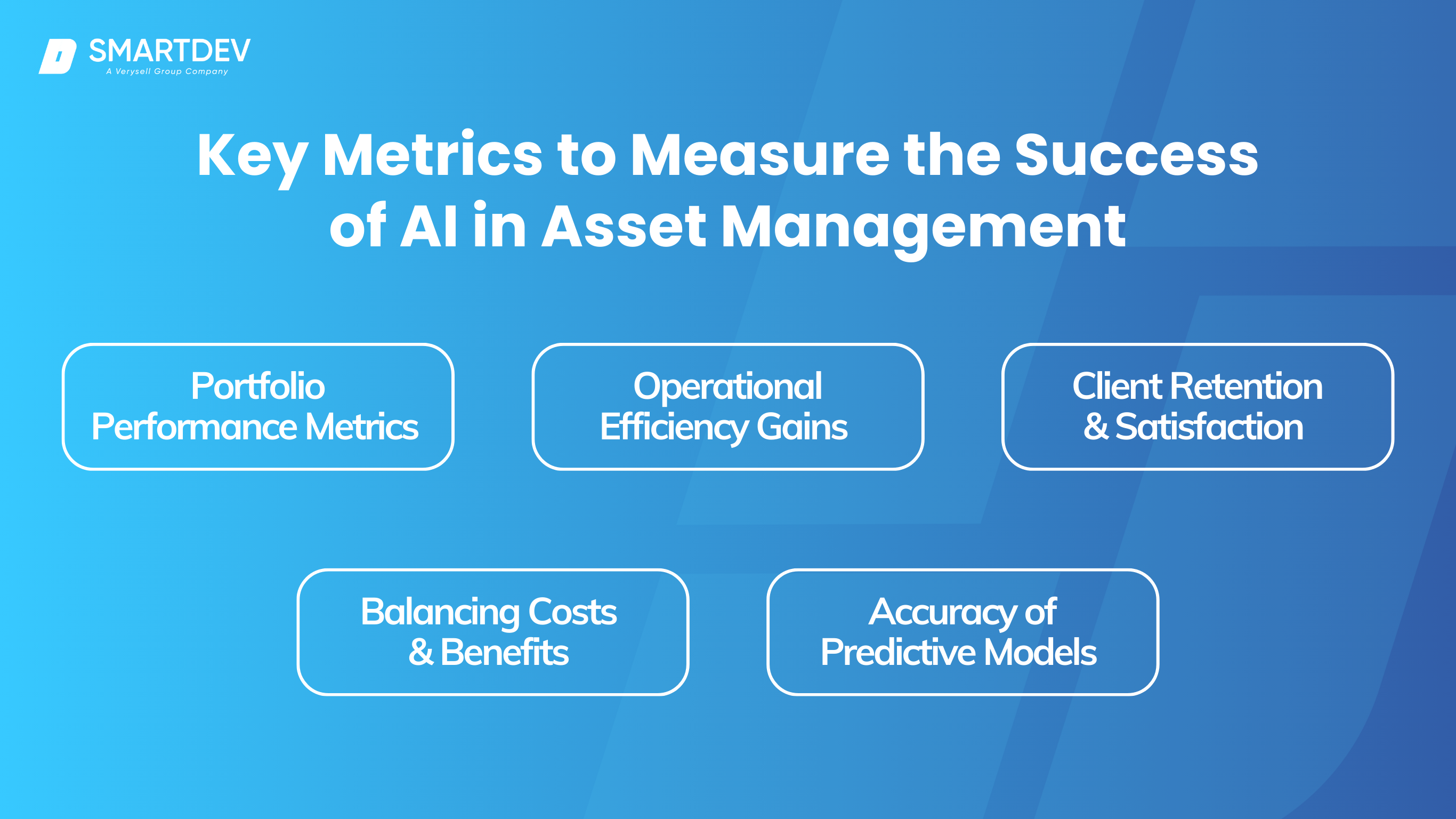
13.1 Portfolio Performance Metrics
Investment returns are the most obvious metric for portfolio management. However, with AI, you also need to look at how well AI-driven strategies improve returns compared to traditional models. Metrics like Sharpe ratio or alpha generation can provide insights into the value AI is adding in terms of risk-adjusted returns.
13.2 Operational Efficiency Gains
AI should lead to a reduction in time spent on routine tasks. Track the time it takes to complete tasks like portfolio rebalancing, compliance checks, or risk analysis before and after AI adoption. Time savings and cost reductions should be significant indicators of success.
13.3 Client Retention and Satisfaction Scores
AI has the potential to improve client satisfaction by providing more personalized services. Tracking client retention rates, satisfaction scores, and Net Promoter Scores (NPS) can help measure how AI is impacting the client experience. Higher satisfaction generally leads to higher retention and loyalty.
13.4 AI ROI: Balancing Costs and Benefits
Investing in AI can be expensive, so it’s essential to measure return on investment (ROI). By comparing the costs of AI adoption (software, training, maintenance) to the savings and additional revenue generated from improved efficiency, better decision-making, and enhanced services, you’ll be able to determine AI’s overall financial value.
13.5 Accuracy of Predictive Models in Risk Management
In risk management, the accuracy of AI’s predictions is crucial. Are the AI-driven models correctly identifying risks? Are they anticipating market downturns or asset volatility with a high degree of accuracy? Tracking the success rate of AI’s risk predictions will give you insight into its effectiveness in managing risk.
Conclusion: The AI Revolution in Asset Management
AI is fundamentally transforming asset management, enhancing decision-making, optimizing portfolios, and improving operational efficiency. As the industry continues to evolve, AI-driven tools are offering asset managers more accurate insights, better risk management, and personalized client experiences. The time to adopt AI is now—those who embrace this technology will have a significant competitive advantage, while those who wait may risk falling behind.
Despite its immense potential, AI integration comes with challenges, such as ensuring data privacy, navigating regulatory frameworks, and maintaining transparency. However, the benefits far outweigh the hurdles, making AI an essential part of the future of asset management. SmartDev is here to help firms harness AI’s power, ensuring they stay ahead of the curve.
—
References:
- AI is transforming asset and wealth management | PWC
- 7 Top Investment Firms Using AI for Asset Management | U.S. News & World Report
- AI in Asset Management: Trends and Challenges in 2025 | Pragmatic Coders
- 10 AI Tools Revolutionizing Portfolio Management and Financial Advisory Services | Lynk Markets
- 5 Best AI Investing Tools for Better Market Results | LevelFields
- Key Features to Look for When Choosing Asset Management Software | Article Cube
- The Future of AI in Asset Management: Key Trends and Technologies | Itemit
- Why AI won’t replace analysts | Financial News London


